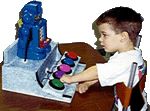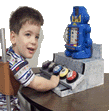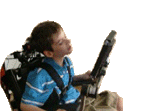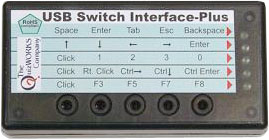Let's Go To The Beach
|
The Let’s Go Series offers a multimedia tool for interaction and
discussion, either one to one or as a group learning activity. There is
no age limit on the programs' suitability and children and adults alike
show great enthusiasm for the travels of the characters. There are lots of different scenes to explore, encouraging users to be creative, to improve their independence and to reinforce basic skills. Each activity is simple, has a sentence or key word text prompt, and the graphics are clear, bold and bright. When using the program, first choose the scenes that you wish to use and set up appropriate access for the learner - number of switches, color and speed of scan etc. See the Configurable Options section for details. Once you have begun the stories, stop at each scene and ask lots of open questions. These might be “What can you see?” “Where are they?” “Why is she doing that?” It is important to use language and discussion with the learner while they interact with the program in order to gain maximum benefit. The link scenes between the activities also encourage discussion as well as providing context. |
|||||||||||||||||||||||||
Loading the carThis fun choosing activity starts the journey chronologically for the user. Two items appear. Choose one to take to the beach and see what the children think about them. Items that are sensible to pack are reinforced with a thought bubble that matches the item to its purpose (e.g. the bucket and spade show a thought bubble of a sandcastle). Some items are inappropriate and the children will reject them. Use this scene to talk about what to take on trips. When you have put four items into the car, the journey will begin! You could play the same sorting game with real objects in the classroom. |
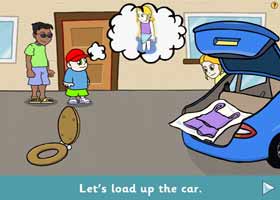
|
||||||||||||||||||||||||
Paddling / WadingEach link screen shows what is to come in the next scene. Use it to improve anticipation skills and to introduce vocabulary. “Which colors are the flags?” “What will they wear?” “How many people can you see?”The paddling/wading scene is an exploring activity that is designed for talking about beach safety. The children can wave to the lifeguard and he can check it’s safe to go in the water. Click on the flags and they’ll blow in the wind. In the sea the children can splash around or find interesting things. This is a scene you can explore over and over again, to talk about all aspects of playing in water safely. |
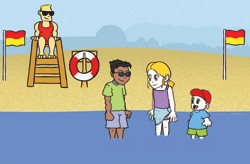
|
||||||||||||||||||||||||
The SandcastleHave fun build a sandcastle! Ask questions to help students describe what they will make. “How many tunnels will you have?” “Will the castle be big or small?” “Which flags do you like?” Start by selecting a bucket, and then choose where it will be placed. When all the castles have been made, select the green arrow for new options for tunnels, shells and flags to adorn the turrets. The program will always produce a good-looking sandcastle. This activity is great for group work, encouraging switch sharing and discussion. |
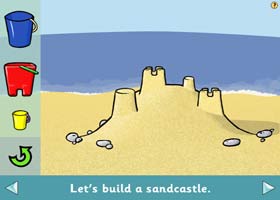
|
||||||||||||||||||||||||
Buying SunglassesThe next link scene shows the girl walking to the shop to buy sunglasses. Talk about what else is on the stand. There are four different pairs of glasses for the girl to try on. These can prompt conversation about choice making, style, fashion and colour, as well as why we wear things to protect ourselves from the sun. Ask your students to name the shapes of the glasses. The chosen glasses remain with the girl in the next scene. |
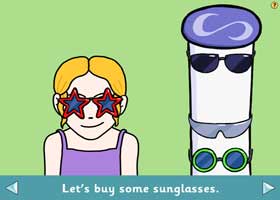
|
||||||||||||||||||||||||
Choosing a HatClick on a hat to make the girl try it on and hear a tune to go with it. The hats can also prompt conversation about choice making, style, fashion, color and protection from the sun. |
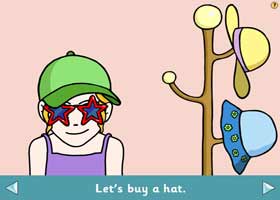
|
||||||||||||||||||||||||
Relaxing on the BeachThis page is about safety on the beach. The girl lies in the shade with her new hat and sunglasses. She can take a drink and apply sun cream. Click on her little brother to make him dig a hole in the sand. The girl reacts kindly to sand being flicked at her legs but if it is flicked in her face she will be angry. This gives students a point to discuss. When is it all right to throw sand? Where and why? Why does she put on cream? Why does she take a drink? The children model good behaviors for students to talk about. |
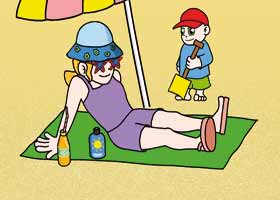
|
||||||||||||||||||||||||
Making a SandwichA fun sequencing activity all about lunchtime. First, select the bread to put a slice on the plate. Then spread butter if you wish, and select any of the fillings to put them in your sandwich. You can add lots of toppings – right to the top of the screen! Add the top slice of bread and watch your sandwich being whisked away and devoured. This activity can be repeated as many times as pupils would like, and is great fun on interactive whiteboards. |
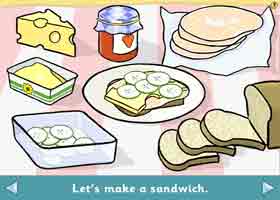
|
||||||||||||||||||||||||
The TelescopeThe link screen shows you the eldest boy walking down the pier to use the telescope. This is a lovely scene to explore the idea of near and far, to talk about things you see at the coast, and to discover more detail through the telescope lens. Ask students questions like “What can you see?” “Who is in the boat?” “What are the children doing?” Some objects such as the hot air balloon move on and off screen, introducing early timing skills. Different sound effects accompany each choice to reinforce what is being seen. |
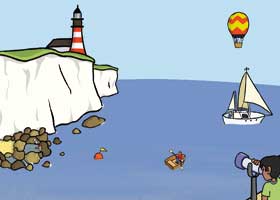
|
||||||||||||||||||||||||
Rock Pool / Tide PoolThe rock/tide pool is shown within the previous telescope activity, providing a link to this scene. This is an exploring and collecting activity. Here students can find what is hiding under the rock and weeds, then choose which creatures to collect in their bucket. Clicking on the bucket will tip the creatures back into the pool – a very important conservation topic to reinforce. Ask questions like “What do you think is hiding under the seaweed?” “How many fish have you found?” “Where else can we look?” “Can you collect three starfish?” |
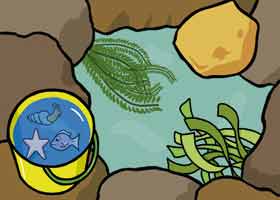
|
||||||||||||||||||||||||
Cleaning UpA sorting activity that is useful for learning about good behaviour on the beach. The learner can help sort out the trash from things to take home and things to leave on the beach, such as a crab or a starfish. Discuss why it isn’t good to leave litter on the beach, and what is sensible to take home. As each item appears, choose between returning it to the rock pool, adding it in the hamper to go home, or putting it in the bin liner. This section is also useful for practicing the new vocabulary learned throughout the many places the children have visited. |
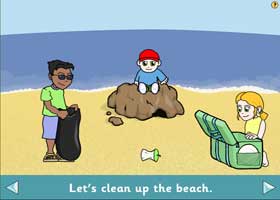
|
||||||||||||||||||||||||
|
Curriculum assessment and targets Though not directly linked to any one system of measurement or assessment, the clear graphics and defined concepts in the Let’s Go Series are excellent for use as part of the curriculum. EQUALS, P-LEVELS, B-Squared, PIVATS, ASDAN and other foundation stages of learning have all been taken into account when designing the programs. Special needs teachers, people working with SLD adults and visually impaired learners all form part of our consultancy team. Main Vocabulary Covered:
Off computer activities |
|||||||||||||||||||||||||

